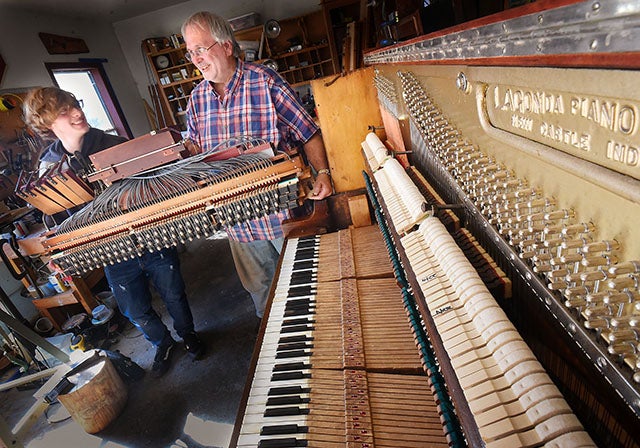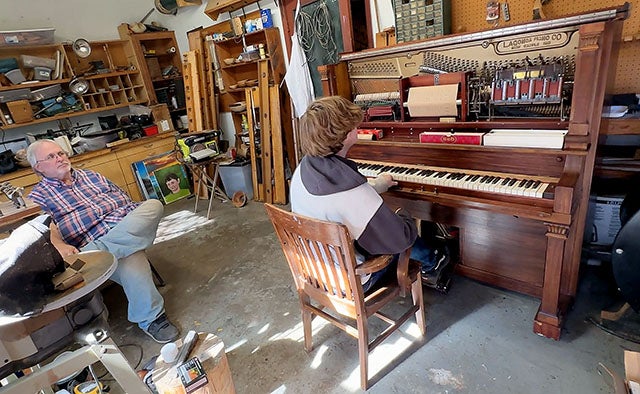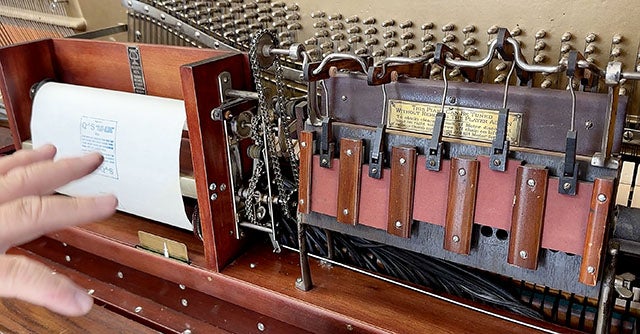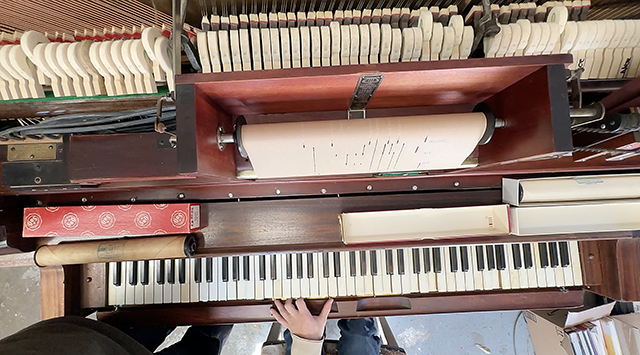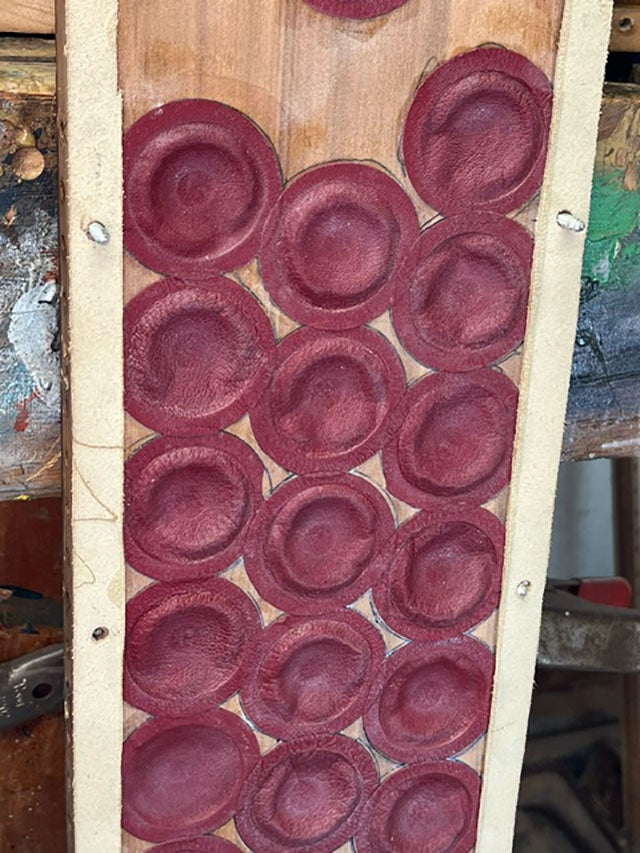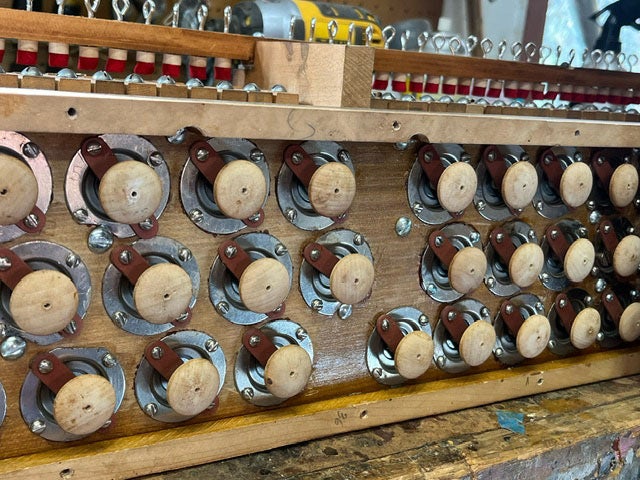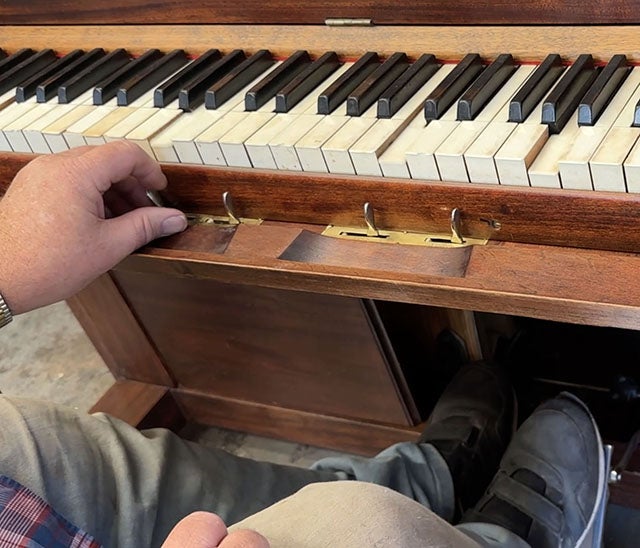Musical magicians: Natchez’s Burnley Cook, protege bring 110-year-old player piano back to life
Published 2:56 pm Saturday, March 30, 2024
|
Getting your Trinity Audio player ready...
|
If Willy Wonka had a music shop, it might have looked a little like Burnley Cook’s garage on Winchester Road in Natchez.
The small building hasn’t seen an automobile in years thanks to all the musical marvels of yesteryear that sit inside.
Many locals already know about Cook’s passion for music and his fascination for instruments that would be lost to history without his attention and care.
On Christmas and other special occasions, Cook plays his calliope from the bed of a pickup truck touring downtown city streets. When his garage door is open and Cook feels like playing, neighbors might be treated to an impromptu concert from the old Baker Grand Theater organ Cook refurbished a few years ago.
And if they are lucky, passersby might catch a few notes from one of the shop’s latest musical wonders — a 110-year-old player piano that Cook and his assistant Joseph Simmons recently tore down and rebuilt piece-by-piece.
A Natchez High School senior, Simmons met Cook in 2019 at the Natchez Little Theater when Simmons was starring in the community theater’s summer youth workshop.
“I think it was during Willy Wonka Jr., and he was looking for someone to do a part in The Mississippi Medicine Show,” the son of Gregg and Jennifer Simmons said.
The two discovered a mutual interest in music and instruments.
“And it took off from there,” Cook said.
Since then, Cook has been teaching and mentoring Simmons on numerous projects, including organ restorations in Port Gibson and Frogmore.
Simmons scrambles inside tight organ chambers and does much of the heavy lifting that Cook says he can no longer do.
“He is my right hand, literally,” Cook said. “He can do anything with his hands. His aptitude for mechanics is strong.”
Since they have been working together, Simmons has learned various skills.
- Joseph Simmons, left, and Burnley Cook hold the upper player action of the upright Lagonda player piano that the two recently refurbished in Cook’s shop. (Ben Hillyer / The Natchez Democrat)
- Joseph Simmons uses his feet to operate the piano player he and Burnley Cook recently refurbished in Cook’s shop. (Ben Hillyer / The Natchez Democrat)
- Burnley Cook points out the many parts that make the player piano work. (Ben Hillyer / The Natchez Democrat)
- A view of the player piano and all of its parts from above. (Ben Hillyer / The Natchez Democrat)
“Mr. Cook has been a great teacher and helped me a lot,” Simmons said.
“I’ve introduced him to several things, including pipe organ work, oil painting, woodworking, lathe turning, and now this,” Cook said, referring to the newly refurbished player piano.
Several years ago, Simmons and Cook came upon a similar piano in Jackson, and Cook said he noticed that Simmons was fascinated by the instrument.
“I told him, ‘You know, I used to do that kind of work. Would you like me to find one, and we restore it?’” Cook said. “And he jumped at the chance.”
Before organ work, Cook said he did regular restoration work on player pianos.
Even today, there are more player pianos than people realize that still exist, Cook said.
“Most of the time, they’ve been relegated to a back room or something,” Cook said. “There are probably at least a good 30 player pianos still around (in Natchez).”
Not long after Simmons expressed an interest, Cook was asked to look at a player piano that wouldn’t work. He told the owner it needed a complete overhaul.
“Then several months later, she called and said, ‘I’m sending it over to you.’” Cook said. “And then it showed up.”
That is how the upright Lagonda player piano manufactured by Jesse French and Sons Piano Co. between 1914 and 1915 ended up in Cook’s shop. Operated by the constant motion of foot pedals, the piano uses a paper roll with punched holes and a series of valves and bellows to make music.
- Cook and Simmons replaced all of the leather pouches that are a critical part of the piano. (submitted by Burnley Cook)
- The maroon leather pouches push up on the mushroom- shaped lifter buttons of the valves. (submitted by Burnley Cook)
- A series of levers on the console help adjust the tempo, transition, loudness and the manual sustain of the piano. (Ben Hillyer / The Natchez Democrat)
“Before radio, this was the preeminent way of entertaining,” Cook said. “If you could not play the piano yourself, you got a player piano. Somebody would be designated as the pumper, and the rest of the people would either sing along or dance.”
Off and on, between other projects, Simmons and Cook worked to rebuild the piano.
“We restrung it about a year and a half to two years ago,” Cook said. “And then it stopped.”
Work on the project then picked up in October 2023 and continued until the piano looked good and was in working condition.
“We tore it down, literally replaced everything,” Cook said. “It was a big job. There’s a lot more to a player piano than people think.”
Cook explained some of the tedious work involved.
“Inside are all sorts of little leather pouches, little leather circles, that inflate to activate valves,” Cook said. “And these valves are these metal stems with leather-faced fiber washers on it.”
“That’s 88 times you have to do everything,” Cook said, referring to the number of keys on the piano.
Cook said Simmons did almost half of the work to rebuild the instrument on afternoons after school and work.
“There’s not a part of it that he didn’t have his hands in,” Cook said. “Indeed, he really helped with removing the plate, fixing the soundboard and restringing with new strings.”
Now that the work on the piano is nearly complete, Cook said he plans to keep it in his shop for enjoyment.
“I guess when I die, Joseph will get it,” Cook said.
Cook said restoring a player piano is fun and sometimes frustrating but is an overall rewarding experience.
“To bring something that is over a hundred years old back to a state where it can be enjoyed is cool,” Cook said.


